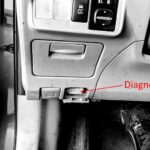Navigating vehicle diagnostics can seem daunting, especially when faced with emissions testing or check engine lights. For 2014 Chevy Sonic owners, understanding the OBD2 port and how it relates to your car’s monitors is crucial. This guide will help you locate your OBD2 port and grasp the concept of OBD2 monitor readiness, ensuring you’re informed and prepared.
Locating the OBD2 Port in Your 2014 Chevy Sonic
The On-Board Diagnostics II (OBD2) port is a standardized interface in modern vehicles that allows access to the car’s computer system for diagnostics and monitoring. In a 2014 Chevy Sonic, you’ll typically find the OBD2 port located beneath the dashboard on the driver’s side.
- Position: Look under the dash, near the steering column, but usually slightly to the left.
- Appearance: The port is usually trapezoidal in shape with 16 pins. It’s designed to be easily accessible for mechanics and car owners alike.
- Accessibility: You might need to crouch down and look upwards to spot it, but it should be in an unobstructed location.
Once you’ve located the OBD2 port, you can connect a compatible scan tool or code reader to access your Chevy Sonic’s diagnostic information. This is the first step in understanding your vehicle’s health and addressing any potential issues.
Understanding OBD2 Monitor Readiness
After connecting your scan tool, you might encounter the term “OBD2 monitor readiness.” These monitors are diagnostic tests that your car’s computer (Engine Control Module or ECM) runs to ensure various emission control systems are functioning correctly. They are crucial for passing emissions tests and ensuring your vehicle is running efficiently.
There are different types of OBD2 monitors, including:
- Catalyst Monitor: Checks the efficiency of the catalytic converter.
- Evaporative System (EVAP) Monitor: Tests for fuel vapor leaks in the evaporative emissions system.
- Oxygen Sensor Monitor: Evaluates the performance of the oxygen sensors.
- EGR System Monitor: (If applicable) Monitors the Exhaust Gas Recirculation system.
- Secondary Air System Monitor: (If applicable) Checks the secondary air injection system.
- Heated Catalyst Monitor: (If applicable) Monitors the heated catalytic converter.
Why Monitors Might Not Be Ready
Sometimes, when you check your OBD2 status, you might find that some monitors are not “ready” or “complete.” This is common after:
- Battery Disconnection: Disconnecting the car battery resets the ECM and the monitor status.
- Code Clearing: Clearing diagnostic trouble codes (DTCs) also resets the monitors.
- Recent Repairs: Some repairs might require the monitors to reset and rerun.
It’s important to understand that monitors not being ready doesn’t necessarily indicate a problem with your 2014 Chevy Sonic. It simply means the car hasn’t completed the self-tests for those systems since the last reset.
Getting Your Monitors Ready: The Drive Cycle
To get the OBD2 monitors to run and become ready, you typically need to perform a “drive cycle.” A drive cycle is a specific set of driving conditions that allows the ECM to run all the necessary diagnostic tests.
While the exact drive cycle can vary slightly between vehicles, a general guideline for many GM vehicles, including the 2014 Chevy Sonic, involves a combination of city and highway driving:
- Cold Start: Ensure the car has been off for several hours so the engine is cold.
- Idling: Start the engine and let it idle for a couple of minutes.
- Moderate Acceleration and Cruising: Drive at moderate acceleration to 45-55 mph and maintain a steady speed for a few minutes.
- Deceleration and Coasting: Safely decelerate and coast down to 20 mph without using the brake if possible.
- Repeat: Repeat steps 3 and 4 multiple times, varying the driving conditions slightly.
- Highway Driving: Drive at highway speeds (55-60 mph) for several minutes.
- City Driving: Return to city driving with stops and starts.
Important Considerations:
- Safety First: Always perform drive cycles in a safe location and obey all traffic laws.
- Specific Conditions: Some monitors, like the EVAP monitor, can be more sensitive and require very specific conditions, such as fuel level and ambient temperature, to run.
- Patience: It might take multiple drive cycles over several days for all monitors to become ready, especially if your typical driving doesn’t match the required conditions.
When to Seek Professional Help
If you’ve performed several drive cycles and some monitors still refuse to become ready, or if you have a check engine light illuminated, it’s advisable to seek professional help.
- Scan for Codes: Use an OBD2 scanner to check for any pending or stored diagnostic trouble codes (DTCs). These codes can provide valuable clues about potential issues.
- Professional Diagnosis: A qualified mechanic can use advanced diagnostic tools to pinpoint why monitors are not running and identify any underlying problems with your 2014 Chevy Sonic’s emission control systems.
- Dealer Assistance: Your local Chevy dealer can also assist with diagnostics and advise on specific drive cycle procedures or potential repairs.
Warranty and Monitor Readiness
It’s important to note that simply having monitors that are not ready is generally not considered a warranty issue unless there is an underlying defect causing the monitors to fail to run. Dealers typically won’t cover the time spent performing drive cycles to get monitors ready under warranty unless a fault is diagnosed.
Conclusion
Understanding the OBD2 port and monitor readiness is a valuable skill for any 2014 Chevy Sonic owner. By locating your OBD2 port and learning about drive cycles, you can take proactive steps to ensure your vehicle is ready for emissions testing and running optimally. Remember, patience and careful driving are often key to achieving monitor readiness. If issues persist, don’t hesitate to consult a professional for expert diagnosis and repair.
